And inverter system comparison of AC power generation, for homestead use.
Let's talk solar. Today I would like to analyze one piece of an alterenate energy system that everybody needs. When we have a battery DC voltage, and we need to run AC equipment we need to convert the DC power to AC power using what's called an inverter.
In simple terms and inverter takes a DC input and switches it through a Transformer and converts it to a higher voltage AC output. What's important with an inverter is that you have the correct AC output voltage and you have an input DC voltage that matches your battery system.
I have selected a 24 volt battery system for my alternate energy needs. The most common system is a 12-volt system and it has a lot of advantages there are also 48 volt systems but they're harder to find inverters for. I settled on the 24 volt because I could still find equipment for it and it cut my DC power bus losses in half. I also intend bus wiring in the house for DC directly, in 24 volts works better for me for lighting, refrigerator, freezer, and ceiling fans. It is important here to select what You are comfortable with because You're going to live with it, or thrive with it!
You also have to be careful because some of the chinese-manufactured inverters list Peak power and not average or RMS power (Root Mean Squared for you purists). Very generically the peak power is going to be about 30% less then what you expect 1000 watt peak power inverter well actually generate an average power of 707 Watts.
Here's a picture of a decent inverter at 1500 watts RMS or average ac power output.
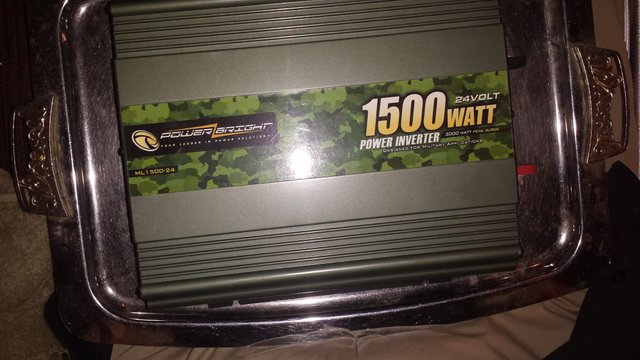
Here is a picture of another inverter that's running 1500 watts but it doesn't specify RMS or average so I'm pretty sure that its peak.
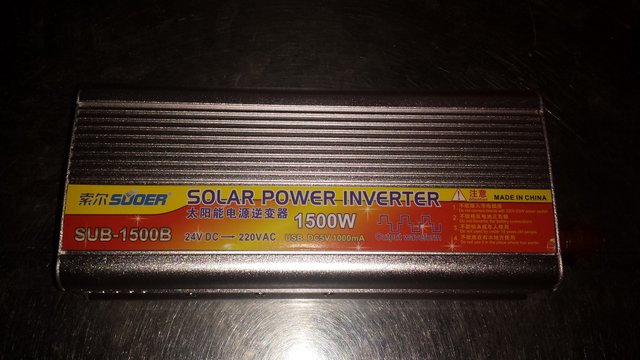
As you can see both units are heatsinked heavily both units also have circulation fans built in. The difference is easier to see in this picture:
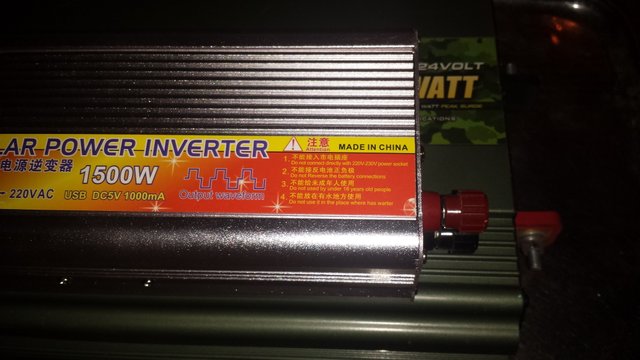
There is an obvious difference between the power handling capability of the silver unit and the black unit. There's also a significant difference in price. They are both 24 volt units and they're both specified at 1500 watts. The black unit was about $160 and the silver unit was $59. Since this is one of the least expensive overall components for an alternate Energy System I don't really recommend that you save money here.
You can see a little bit more difference looking at the DC input side on the way the terminals are made. The good one looks like this:
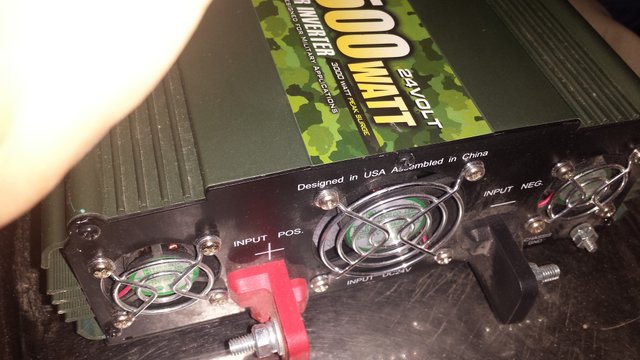
The inexpensive one looks like this:
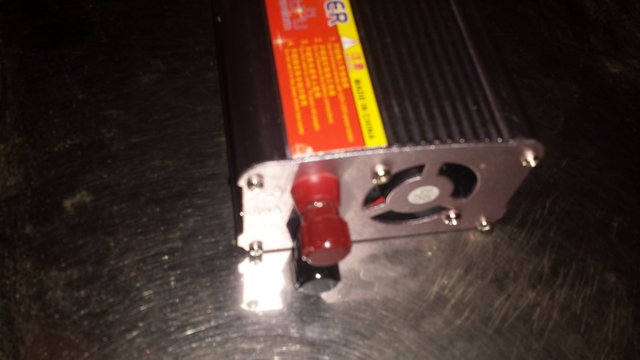
It's also good to know that this point in time that in these two pictures of the input side you can see the difference in air circulation one has a single small fan the other has three fans with one being a larger one. Greater cooling means longer life for a power inverter. You also should Mount these inverters vertically with the fans on the bottom so that natural convection will assist the fan and circulating air.
Alternately, if you don't have that option you can mount them horizontally, as an acceptable second best mounting.
We see the output side in these pictures and it's nice but not necessary to have metering built into the inverter. Some people think that this is just one more thing to break, but I like it.
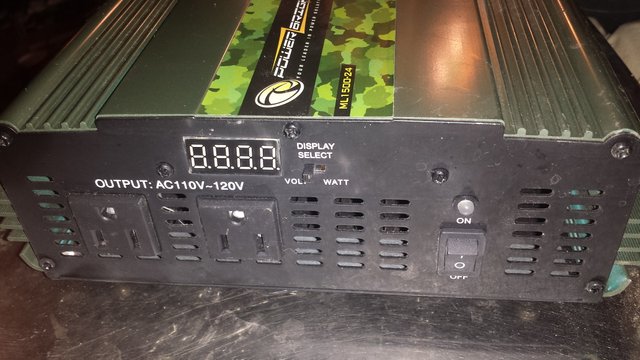
Here's the front panel on the inexpensive unit:
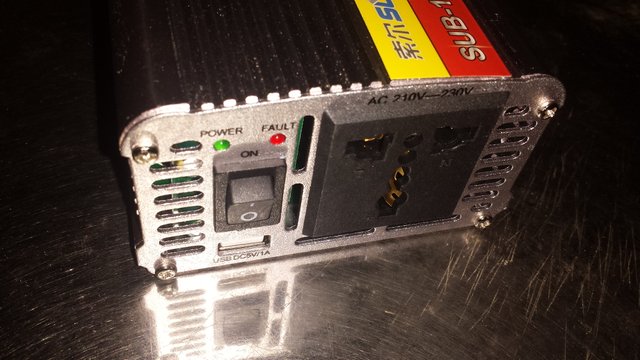
At least your pictures you'll see the only significant difference between the two be on the power that we discussed earlier. The inexpensive unit is a 220 volt unit, while the heavier unit is 120 volt.
With a true RMS 120 volt 1500 watt inverter I can count on 12.5 amps of AC power. With the inexpensive unit I have to be a little more careful. At 1500 watts Peak I have to multiply the peak rating by 0.707 and I end up with an average value of 1060 Watts. At 220 volts ac I will end up with 4.8 amps of AC power from this inverter.
The inexpensive unit was purchased to run my air conditioner at my Homestead which draws 900 watts at 220 volts ac. So technically this inexpensive will supply enough to run that air conditioner. But I will buy another unit to actually use and keep this as a reserve because I don't like to run that close to rating.
So even with a EE, degree and a lot of studying on Alternate energy I got burned on this inexpensive unit myself. One of the things to avoid on an inverter is running it at capacity. You will shorten the life and you'll run into what's called line sag. Line sag is where the voltage drops under load and the unit being run will compensate by drawing more current. On a loaded inverter or a power line this promotes more line sag, so it's a self-destructive circle. I like to run my inverters no higher than 70%.
There's one other pet peeve I have on Alternate power. People insist that you cannot run a resistive heating unit of any kind on a alternate Energy System because it will eat up the entire system reserve. This is not true the power used is a function of the power of the device and the amount of time used. If you have the inverter power available there's no reason you can't use a toaster. It draws for a couple of minutes at 1500 watts and that's not going to drain any decent system. A toaster using 1500 watts for 2 minutes will burn 50 watts from your battery. Homesteading does not require that we return to the Stone Age. I am moving off grid and homesteading for a better life, not to put my life on hold and just scrape to get by!
This is not to say you can run a crock pot. Because it runs for 10-12 hours; that is the kind of power drained that can hurt a system's reserve capacity.
Note: one last thing, you have to feed these puppies! An inverter with two light a feed on the DC side will cause the inverter to fail. This is because line sagging occur at both ends. When you have a 1200 watt average power inverter running on a 12-volt DC system you will draw 100 amps of DC from the batteries to supply that 1200 watts. You have to have real wire to carry a hundred amps it should look like the starter wire on your car or the battery wire on your car! If the line voltage on the input side drops more than a couple tenths of a volt under load you need more copper. Don't skimp here if you're not sure you can run one two three or four more wires in parallel to get more cross section to the DC feed. This is very important this is the most common failure in an alternate energy set up. If the wires getting hot or if the line is sagging you need to do something immediately!
With the 24 volt system I have chosen, that same inverter will only draw 50 amps, so my copper stays cooler.
Happy homesteading, and stay blessed!
You don't say whether these are pure sine wave or modified sine wave. Most equipment works better with pure sine wave.
Posted using Partiko Android
True, but I was trying for an entry level or introduction type post. The waveforms and relative advantages are for another post. I want to power them up, and put an oscilloscope on them to help explain. Some people need the visuals to understand waveforms.
I will have the replacement inverter due shortly for a true sine wave example. I will use that cheap one as the stepped waveform example.
Keep on homesteading!
:)>Thanks, looking forward to that post.
Posted using Partiko Android
Soon, but describing a sine wave, without pictures is not going to do much good. I am trying to help people understand enough to build their own. They do NOT need to know how to run the Oscilliscope, or calculate inductive loading to use a predesigned component sucessfully.
I would LOVE to build an inverter from scratch, and I might once everything is running on the homestead. THAT would be a little too complex for a post though, LOL!
But I will put the battery build on here.
:)>this one lost me sir smithlabs, besides I only have 30 seconds to spend on each post and this one is way too long.
If you are going to add a solar power system, Read the entire content! This is only part of the information on inverters. I have another post in process, on inverter waveforms and efficiencies, that will also be important for homestead power systems.
Some of the stuff i have to write will blow your 30 second rule!
I am working on an E-book right now on homestead power systems. It will help me set up my website. You are getting a free preview, LOL!
:)>hey don't tell me what to do. I don't have to read squat! lol.Besides, why read something I can't comprehend? lol..When the time comes I'll read your ebook but that time may be a couple years away. By that time who knows where we'll be in new inventions with solar, right?
Well you need to read my recent battery post:
https://steemit.com/battery/@smithlabs/new-fast-charge-solid-state-battery-design-is-three-times-more-energy-dense-than-liion-and-will-not-burn-if-shorted
I have about 25 pages thus far on the book, but I still have that post on waveforms, and I have to write on batteries, solar panels, solar charge controllers, and wind generators. A ways to go yet....
May go way past an E-Book, size wise.
You know that you are 95% of my replies on steemit these days? Your post on the sash warriors may just be hurting from a lack of people....
I busted $5000.00 on weku, and (71); you really should come play, LOL! I aam having FUN! @information wars has set up there now too.
:)>I don't have to read nothin sir smithlabs! When and if we finally decide to check out solar I'll do some reading. If I read about it now and in a few years decide to go that direction I will have forgotten most of what I read anyway. Besides I'll just hire smithlabs as a consultant because by that time you'll have your own system working, I hope.
Maybe Momma will read it to you! :)
I am also hoping for that! But exposing your grey matter multiple times increases understanding of the material.
I hope you get a system in place because it might be the only power you have left, if things cook off. If not, you will save money on power, and consume less fuel! Win Win...
well lets see if your system works first.
Well, since I can design these factory made units, and I only need to put them together, I feel pretty safe. it will run, and should run signofocantly better.
The only deviation from the normal, is the batteries. They are not the usual choice, because of cost; but by salvaging them from old packs, I have forced the price down to a minimum, that makes this better design reachable.
The other big improvement will be the ability to move the solar panels that will make the panels produce more power, by making every daytime hour effectively noon.
:)>I run a kettle, toaster and toaster oven etc no probs on my solar setup running a 12v system it can sure been done.
Posted using Partiko Android
Good for you! all we need to do is have enough inverter capacity. I hate it when people that have moved off grid, ar just surviving.
I intent to use an inductive cook top to cook my breakfast in a cast iron skillet.
When I get my system expansion done, I want get to the point of ignoring that I am off grid entirely.
But the first step is making the homestead energy efficient, I am working on that now. I sure am glad that life is NOT boring, LOL!
:)>Lol no life ain't boring.
Posted using Partiko Android
I need to get out to the homestead as quickly as possible. It is by a Large lake, and I need to work in some fishing time, LOL!
Power first, fishing later....
:)>Better get that power done quickly then so you can go fishing:)
Posted using Partiko Android
That is gospel, for sure, LOL! I will start with a basic mount, then replace it with an obsolete satellite dish. I will replace the dish portion, with a flat solar panel mounting rack; to track the sun.
:)>Very nice hope you show us the finished product. :-)
Posted using Partiko Android
I will, but the dish upgrade is after the fishing, LOL!
♡♡♡♡♡Congratulations @smithlabs! You have completed the following achievement on the Steem blockchain and have been rewarded with new badge(s) :
You can view your badges on your Steem Board and compare to others on the Steem Ranking
If you no longer want to receive notifications, reply to this comment with the word
STOPThanks for keeping track!
:)>Great post, a lot of good useful info here! Nice one..
Glad you liked it, I should have the replacement inverter in soon, and I want to compare oscilloscope waveforms with the silver one to help explain efficiencies.
Hard to make things simple on some more complex differences, but I will try here. The pure sine wave output is the best, and runs a lot more efficiently.
I probably need to do a separate post on expected efficiencies. A lot of people have bad experiences with alternate power systems , because they don't understand that systems have efficiencies to include. So when they do NOT get as much power as they expected (AKA 100%); they sour on Alternate power systems.
So I meed to hit that hard.
Be Blessed
:)>